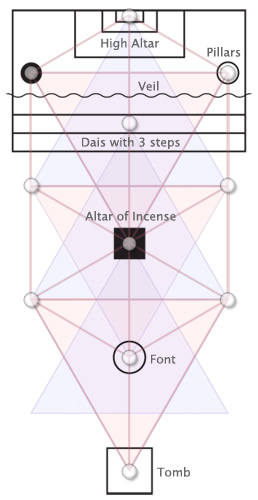The Gnostic Mass
(Revision as of 09:48, 4 Nov 2004)
Categories: Thelema | Ecclesia Gnostica Catholica | Rites & Rituals
Aleister Crowley wrote The Gnostic Mass—technically called Liber XV or "Book 15"—in 1913 while travelling in Moscow. In many ways it is similar in structure to the Mass of the Roman Catholic Church. However, the comparison ends there, as the Gnostic Mass is a celebration of the principles of Thelema. The ceremony calls for five officers: a priest, a priestess, a deacon, and two acolytes, called “children”. The end of the ritual culminates in the consumation of the eucharist, which is a glass of wine and the host, called a Cake of Light, after which the congregant proclaims “There is no part of me that is not of the gods!”
It is the central rite of Ordo Templi Orientis and it's ecclesiastical arm, Ecclesia Gnostica Catholica.
As for why Crowley wrote the Gnostic Mass, he explains in Confessions:
- While dealing with this subject I may as well outline its scope completely. Human nature demands (in the case of most people) the satisfaction of the religious instinct, and, to very many, this may best be done by ceremonial means. I wished therefore to construct a ritual through which people might enter into ecstasy as they have always done under the influence of appropriate ritual. In recent years, there has been an increasing failure to attain this object, because the established cults shock their intellectual convictions and outrage their common sense. Thus their minds criticize their enthusiasm; they are unable to consummate the union of their individual souls with the universal soul as a bridegroom would be to consummate his marriage if his love were constantly reminded that its assumptions were intellectually absurd.
- I resolved that my Ritual should celebrate the sublimity of the operation of universal forces without introducing disputable metaphysical theories. I would neither make nor imply any statement about nature which would not be endorsed by the most materialistic man of science. On the surface this may sound difficult; but in practice I found it perfectly simple to combine the most rigidly rational conceptions of phenomena with the most exalted and enthusiastic celebration of their sublimity.
Crowley published the text of the Gnostic Mass three times: in 1918 in a publication called The International, in 1919 in The Equinox (III:1), and in 1929 in Magick in Theory and Practice. It was privately performed while Crowley was at the Abbey of Thelema, and it's first public performance was March 19, 1933 by Wilfred T. Smith and Regina Kahl in Hollywood, California at the first Agape Lodge.
| Table of contents |
The Temple

There are four main pieces of furniture in a Gnostic Mass temple:
The High Altar: the dimensions are 7 feet long by 3 feet wide by 44 inches high. It is covered with a crimson cloth. It is situated in the East, or faces Boleskine in Scotland. The two-tiered super-altar sits on top of the High Altar. It all holds 22 candles, the Stele of Revealing, the Book of the Law, and two bunches of roses. There is room for the Cup, the Paten, and the Priestess to sit.
The High Altar is contained within a great Veil, and sits on a dais with three steps. On either side of the High Altar are two pillars, countercharged in black and white.
The Altar of Incense: to the West of the Dais is a black altar made of superimposed cubes.
The Font: this is a small circular item which is able to contain or hold water.
The Tomb: this is generally in the shape of an upright coffin, but the essential is that it is a small, enclosing space with an entrance that is covered by a veil.
Structure
There are six component ceremonies within the Gnostic Mass:
The Ceremony of the Introit
The congregation enters the temple, the Deacon presents the Law of Thelema, and the Gnostic Creed is recited. The Priestess and the Children enter from a side room. The Priestess raises the Priest from his Tomb.
The Ceremony of the Rending of the Veil
The Priestess is enthroned at the High Altar and the veil is closed. The Priest circumambulates the temple and he ascends to the veil. The officers give their orations, including the Calendar by the Deacon. The Priest then opens the veil and takes his place at the High Altar.
The Collects
Eleven prayers addressed to the Sun, Moon, Lord, Lady, Saints, Earth, Principles, Birth, Marriage, Death, and the End.
The Consecration of the Elements
The preparation of the Eucharist.
The Anthem
Of the Anthem, Crowley writes in Confessions:
- During this period [i.e. around 1913] the full interpretation of the central mystery of freemasonry became clear in consciousness, and I expressed it in dramatic form in The Ship. The lyrical climax is in some respects my supreme achievement in invocation; in fact, the chorus beginning: “Thou who art I beyond all I am...” seemed to me worthy to be introduced as the anthem into the Ritual of the Gnostic Catholic Church.
The Mystic Marriage and Consummation of the Elements
The Eucharist is perfected and consumed. The Priest gives the final benediction. The officers exit.
Links of Interest
- The full text of Liber XV (http://www.scarletwoman.org/docs/docs_mass.html), The Gnostic Mass
- A First Look at the Gnostic Mass (http://www.scarletwoman.org/docs/docs_firstlook.html), by Dionysos Thriambos
- Original Essays and Propoganda (http://www.hermetic.com/dionysos/essays.htm) of Dionysos Thriambos regarding the Gnostic Mass & the E.G.C.
- The Gnostic Mass: Annotations and Commentary (http://www.hermetic.com/sabazius/gmnotes.htm) by Helena and Tau Apiryon
References
- Sabazius. (1998). Introduction to the Gnostic Mass (http://www.hermetic.com/sabazius/intromass.htm). Retrieved Nov. 3, 2004.
- Crowley, Aleister. (1979). The Confessions of Aleister Crowley. London;Boston : Routledge & Kegan Paul.
- The Gnostic Mass: Annotations and Commentary (http://www.hermetic.com/sabazius/gmnotes.htm) by Helena and Tau Apiryon
![[Main Page]](http://www.thelemapedia.org/images/logo.gif)